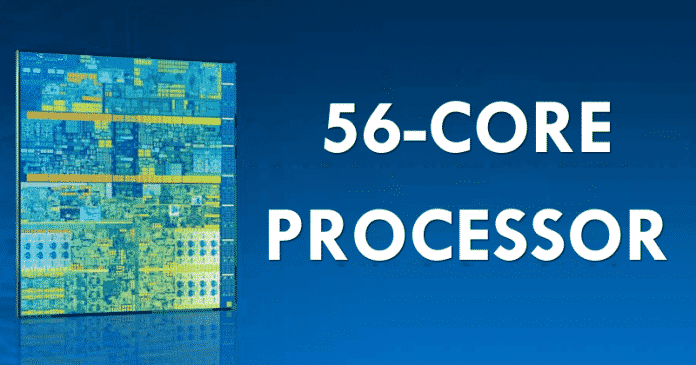

We all know very well that a few months ago only the giant chip manufacturer, of course, Intel announced a 48-core Xeon processor, and the company now features an even more generous chip in numbers: the new Xeon Cascade Lake Advanced Performance chip features 56 cores and 112 cores threads.
Meet The Intel’s All-New Monstrous 56-Core Processor
Just a few months ago only the giant chip manufacturer, of course, Intel announced a 48-core Xeon processor, and the company now features an even more generous chip in numbers: the new Xeon Cascade Lake Advanced Performance chip features 56 cores and 112 cores threads.
And not only that even it also has support for the Intel Optane DC memories, which is another draw of the line. To be more precise, we are talking about the second generation of the Xeon Scalable family, which is divided into four lines: Xeon Bronze, Xeon Silver, Xeon Gold, and Xeon Platinum.
Also Read: Best Computer Tricks 2019 and Hacks for Your Window PC
With the exception of the Bronze series, which has a single model (Xeon Bronze 3204), each of the lines has several chips. It seems like an exaggeration, but the giant chip manufacturer, Intel’s goal with this variety is to serve a wide range of applications, hence, some chips are targeted at activities with large amounts of RAM, others are network-oriented and so on.
The 56-core Cascade Lake appears as the most powerful model in this series which is released by Intel and it offers four options in the Platinum 9200 series:-
- Intel Xeon Platinum 9282: 56 cores, 112 threads, 2.6 GHz frequency (maximum 3.8 GHz), 77 MB L3 cache, 400W TDP.
- Intel Xeon Platinum 9242: 48 cores, 96 threads, 2.3 GHz frequency (maximum 3.8 GHz), 71.5 MB L3 cache, 350W TDP.
- Intel Xeon Platinum 9222: 32 cores, 64 threads, 2.3 GHz frequency (maximum 3.7 GHz), 71.5 MB L3 cache, 250W TDP.
- Intel Xeon Platinum 9221: 32 cores, 64 threads, 2.1 GHz frequency (maximum 3.7 GHz), 71.5 MB L3 cache, 250W TDP.
These processors are directed to servers or applications that demand a lot of performance, and this explains the generous numbers and not only that even the giant chip manufacturer Intel itself recommends a good liquid cooling system for the Xeon Platinum 9282, as it has 400W.
To reach so many cores, the giant chip manufacturer Intel resorted to a Multi-Chip Module (MCM) approach. This means that each processor is formed by two dies in the same encapsulation. While the Xeon Platinum 9282, for example, is made up of two 28-core Cascade Lake XCC (Extreme Core Count) chips.

As Tom’s Hardware points out, the two dies allow the processor to have access to 12 channels of DDR4 memory of 2933MHz. With this, a dual socket server equipped with Cascade Lake AP chips can count up to 3TB RAM and transfer memory up to 407GB/s (gigabytes per second).
There are no major structural changes, as the new Cascade Lake AP Xeon chips continue to be based on the Purley platform which, in turn, is based on the 14nm + 14nm Skylake architecture to be exact. As the giant chip manufacturer, Intel says, however, that optimization has improved the performance of the new chips by up to 30% compared to the previous generation.
Moreover, with the huge number of cores, Intel draws attention to other attributes, such as the previously mentioned DDR4 memory support of 2933MHz (versus up to 2666MHz in the previous generation). In addition, each chip now supports up to 1.5TB of RAM (hence the 3 TB of dual-socket RAM mentioned above).
Support for new Optane DC (Data Center) persistent memory DIMMs is another highlight, as the technology works as a sort of bridge between RAM and storage, essentially. As the data remains stored in the modules even when the computer is shut down so that the information gets loaded faster at startup.
Also Read: How To Create Computer Virus In Few Seconds (Notepad virus tricks)
Basically, these new series of Intel chips are the solutions against the Meltdown and Specter failures. While the giant chip manufacturer Intel mitigated these hardware-level issues, and because of that, performance should be less affected than firmware-enforced fixes.
While now if we talk about the price then let me clarify that the giant chip manufacturer Intel did not disclose the price of the 56-core processor, but for the price assumtion we all know that the new Platinum 8280 (28 cores), which is the most advanced model of the 8200 Platinum Series starts at $10,000. So, what do you think about this? Simply share all your views and thoughts in the comment section below.


